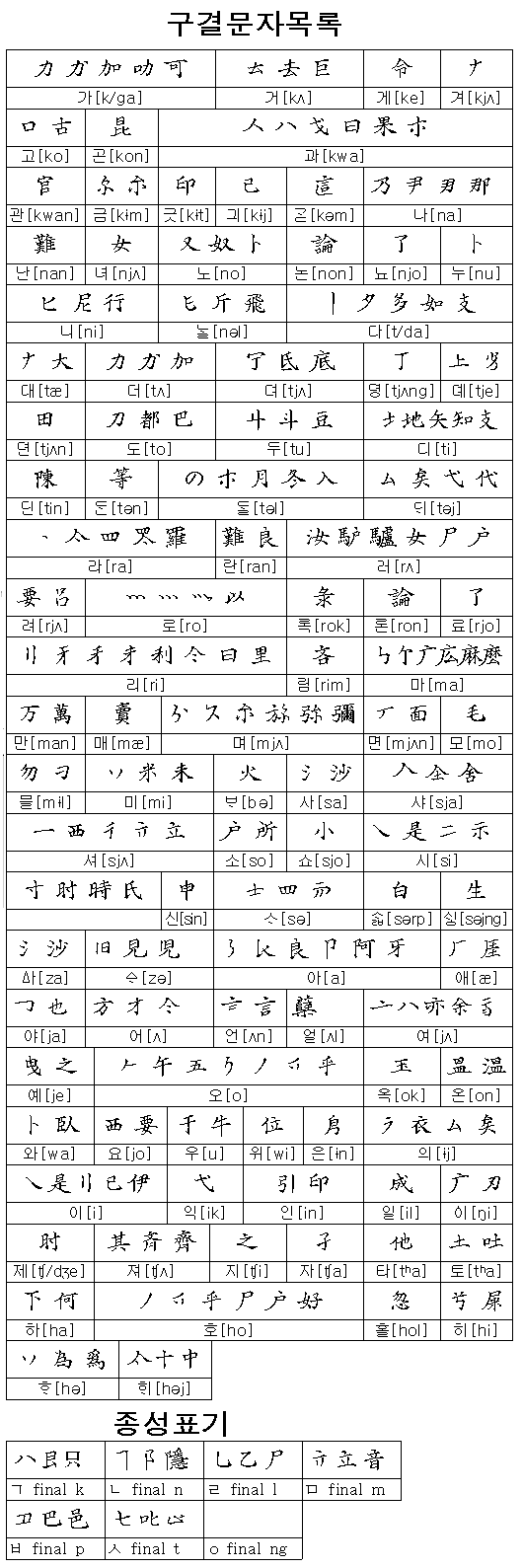Gugyeol
This article should specify the language of its non-English content, using {{lang}}, {{transliteration}} for transliterated languages, and {{IPA}} for phonetic transcriptions, with an appropriate ISO 639 code. Wikipedia's multilingual support templates may also be used. (October 2023) |
| Gugyeol | |
| Hangul | 구결 / 입겿 |
|---|---|
| Hanja | |
| Revised Romanization | Gugyeol / Ipgyeot |
| McCune–Reischauer | Kugyŏl / Ipkyŏt |
 |
| Korean writing systems |
|---|
| Hangul |
| Hanja |
| Mixed script |
| Braille |
| Transcription |
| Transliteration |
|
Gugyeol, or kwukyel, is a system for rendering texts written in
The parts of the Chinese sentence would then be read in Korean out of sequence to approximate Korean (SOV) rather than Chinese (SVO) word order. A similar system for reading Classical Chinese is still used in Japan and is known as
Gugyeol is derived from the
Etymology
The name gugyeol can be rendered as "phrase parting" and may refer to the separation of one Chinese phrase from another. This name is itself believed to originate from the use of hanja characters to represent the Middle Korean phrase ipgyeot (입겿), with a similar meaning. Gugyeol is also sometimes referred to as to (토, 吐), or hyeonto (현토, 懸吐), since to is also used to refer to the morphological affixes themselves or as seogui (석의, 釋義), which can be rendered as "interpretation of the classics."
History
Gugyeol is first attested from the 11th century in the early
The term gugyeol is often extended beyond this early system to similar uses of hangul following the introduction of the Hunminjeongeum in the 15th century. In this respect, gugyeol remains in occasional use in contemporary South Korea, where such techniques are still sometimes used to render the Confucian classics into readable form.
Gugyeol should be distinguished from the idu and hyangchal systems, which preceded it. Gugyeol used specialized markings, together with a subset of hanja, to represent Korean morphological markers as an aid for Korean readers to understand the grammar of Chinese texts. Also, the idu and the hyangchal systems appear to have been used primarily to render Korean into hanja; on the other hand, gugyeol sought to render Chinese texts into Korean with a minimum of distortion.
Table of Gugyeol
This section may need to be changing this notice to be more specific . (March 2022) |
See also
References
- ISBN 978-89-5966-389-7.
Further reading
- Kim Mu-rim (김무림) (2004). 국어의 역사 [History of the Korean language]. Seoul: Hankook Munhwasa. ISBN 89-5726-185-0.
- Kwon Jae-seon (권재선) (1989). 간추린 국어학 발전사 [An abridged history of Korean language studies]. Seoul: Ugoltap.


